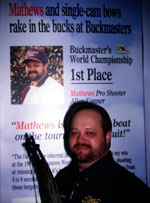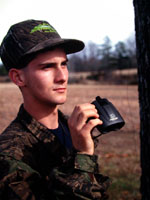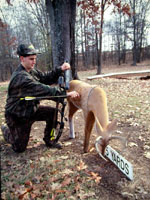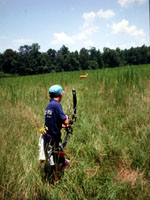
|
Features
|
|
|
|
Books
|
|
|
|
Fun & Games
|
|
|
|
Contact Us
|
|
|
John's Journal... Entry 160, Day 2
THE DISTANCE TO SUCCESS
Study Target Size
 EDITOR'S
NOTE: Many hunters prepare for hunting season by shooting 3D archery.
Several critical elements will help you win 3-D archery tournaments, including
your bow's ability to perform flawlessly, skill at holding the bow steady
through the shot, control over your nerves and emotions in the face of
high-pressure competition and the ability to judge your distance from
the target. 3-D tournament archers often find judging distance the one
chink in their armor. Misreading the distance even by 1/2 to 1 yard can
determine whether you hit the 12 ring or the 8 ring. Most of the nation's
best 3-D archers utilize more than one technique to judge distance to
a target. Here are some of their secrets.
EDITOR'S
NOTE: Many hunters prepare for hunting season by shooting 3D archery.
Several critical elements will help you win 3-D archery tournaments, including
your bow's ability to perform flawlessly, skill at holding the bow steady
through the shot, control over your nerves and emotions in the face of
high-pressure competition and the ability to judge your distance from
the target. 3-D tournament archers often find judging distance the one
chink in their armor. Misreading the distance even by 1/2 to 1 yard can
determine whether you hit the 12 ring or the 8 ring. Most of the nation's
best 3-D archers utilize more than one technique to judge distance to
a target. Here are some of their secrets.
Allen Conner of Attalla, Alabama, has won the Buckmasters Indoor Championship before as well as the Cabela's NABH Manufacturers' Championship, the Cabela's Missouri Open National Championship and the IBO Triple Crown National Championship besides having 10, top-five national finishes and 15 top-10 national finishes.
"The first process I use to judge a target is to look at the animal target and judge how big it appears from where I'm standing," Conner said. "I've studied all the animals in the McKenzie target line at different ranges. The relative size of the target when you look at it will tell you how far you are from the target if you look at the target long enough and you've shot it in many tournaments.
 "When
I first step up to the stake and look at the target, I may think that
the target is at least 35 yards and no more than 42 yards away. I'm so
accustomed to looking at those McKenzie targets that I can judge the distance
fairly accurately just by looking at the target. I make my second measurement
by looking at the ground. Since I know how far 5 yards is, I judge the
distance to the target in 5-yard increments. At my home, I've put stakes
in the ground every 5 yards from five to 50 yards out. I'll look at those
stakes and study the ground between the stakes to help me learn to judge
distance in increments of 5 yards. When I finish my 5-yard judging, I
may say, 'Okay, that target is 1-1/2 yards past my 45-yard mark.' Then
I'll know the target is 46 1/2-yards from the stake. The terrain also
affects my ability to judge yardage. On an uphill shot and a downhill
shot, you're going to shoot high even if you're shooting the right yardage
because of the trajectory of the arrow. When shooting up and down hills,
you have to shoot somewhat lower than you normally will on flat ground.
"When
I first step up to the stake and look at the target, I may think that
the target is at least 35 yards and no more than 42 yards away. I'm so
accustomed to looking at those McKenzie targets that I can judge the distance
fairly accurately just by looking at the target. I make my second measurement
by looking at the ground. Since I know how far 5 yards is, I judge the
distance to the target in 5-yard increments. At my home, I've put stakes
in the ground every 5 yards from five to 50 yards out. I'll look at those
stakes and study the ground between the stakes to help me learn to judge
distance in increments of 5 yards. When I finish my 5-yard judging, I
may say, 'Okay, that target is 1-1/2 yards past my 45-yard mark.' Then
I'll know the target is 46 1/2-yards from the stake. The terrain also
affects my ability to judge yardage. On an uphill shot and a downhill
shot, you're going to shoot high even if you're shooting the right yardage
because of the trajectory of the arrow. When shooting up and down hills,
you have to shoot somewhat lower than you normally will on flat ground.
 Derrick
Phillips now with Mathews Archery has a been member of the National Cabela's
Team Champions, finished second in the Florida ASA Tournament, second
in Mesa, Arizona, on the Cabela's Circuit, second in the IBO World Championships
and second in the Nelsonville Tournament in the IBO Triple Crown Circuit.
Derrick
Phillips now with Mathews Archery has a been member of the National Cabela's
Team Champions, finished second in the Florida ASA Tournament, second
in Mesa, Arizona, on the Cabela's Circuit, second in the IBO World Championships
and second in the Nelsonville Tournament in the IBO Triple Crown Circuit.
"When I step up to the stake, I immediately estimate my range from the target," Phillips reported. "As soon as I make my first guess, I set my sight because then I'll remember to set my sight differently from where I had it set at the last target. Before I shoot, I'll judge the ground in 10-yard increments from where I'm standing to the target. When I get closer to the target, I'll judge the ground in 5-yard increments or 1-yard increments until I feel like I know my distance from the target. Then I'll move off to the side of the target and try and look at the target from a different angle. I'll ask myself if the target looks smaller or larger than it should from this distance. Knowing how I've judged that target in the past, I'll also come up with a third distance number. Then I'll take all three distances, average them, and shoot the average. If the target has a center 12 ring or is an ASA target where the 12 ring is at the bottom of the target, I'll shoot the target for the longest distance of those three numbers. The center 12 ring, which the IBO and the Cabela's tournaments have had is in the middle of the 10 ring, which means if you shoot for the 12 and miss it slightly, you'll still hit the 10.
 "But
the ASA 12 ring is located in the bottom corner behind the front shoulder
of the target. If you underjudge the distance, you'll hit in the 8 ring.
On this target, I'd rather shoot over the 12 ring than to shoot under
the 12 ring. If I can't decide whether the target is closer or further
away than the average number that I've come up with tends to indicate
that it is, I'll generally shoot the longer yardage. Another tip that
has helped me to learn to judge distance is that I carry a small notebook
with me in tournaments. I write down what I initially judge a target to
be, the distance I believe the target to be when I groundcheck it and
the distance I estimate when I stand off to the side of the target. Next,
I write down the distance for which I've set my sight. When the tournament
is over, I find out the exact distance from the stake to each one of the
targets I've shot. Then I go back and study my notebook after the tournament
to see if I'm developing a consistent pattern of arrows and to see which
one of my measuring systems seems to be the most accurate.
"But
the ASA 12 ring is located in the bottom corner behind the front shoulder
of the target. If you underjudge the distance, you'll hit in the 8 ring.
On this target, I'd rather shoot over the 12 ring than to shoot under
the 12 ring. If I can't decide whether the target is closer or further
away than the average number that I've come up with tends to indicate
that it is, I'll generally shoot the longer yardage. Another tip that
has helped me to learn to judge distance is that I carry a small notebook
with me in tournaments. I write down what I initially judge a target to
be, the distance I believe the target to be when I groundcheck it and
the distance I estimate when I stand off to the side of the target. Next,
I write down the distance for which I've set my sight. When the tournament
is over, I find out the exact distance from the stake to each one of the
targets I've shot. Then I go back and study my notebook after the tournament
to see if I'm developing a consistent pattern of arrows and to see which
one of my measuring systems seems to be the most accurate.
"Also in my notes, I record what type of target we shoot at each station. For instance, I've learned that the target we call a generic deer tends to be a little smaller than some of the other McKenzie targets, which means shooters may judge it to be further away than it is. Too, I usually underestimate the distance to the brown walking bear because this target is actually bigger than what it appears to be. By studying my notes, if I have to shoot this particular target in a tournament, I'll always add 1 or 2 yards to the distance I determine the target to be."
TOMORROW: STEPPS' METHODS FOR JUDGING DISTANCE
Check back each day this week for more THE DISTANCE TO SUCCESS ...
Day 1 - Judging Distance
Day 2 - Study Target Size
Day 3 - Stepps' Methods For Judging Distance
Day 4 - Using A Range Finder To Judge Distance
Day 5 - Use Multiple Systems To Determine
Distance